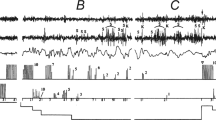Abstract
The study of consciousness is crucial to understand how the human mind functions. Within the last twenty years new approaches to this question have been formulated and “establishing neural consciousness correlations” is one of the most promising. The sleep-wake paradigm is one of the most promising methodologies in this field, allowing the study of healthy subjects without medical interventions. We developed a monotonous psychomotor test that induces several episodes of losing consciousness because of falling asleep and its full or partial recovery while awakening within the 60 min. The following behavioral measures of consciousness level were noted: counting accuracy, time between presses, pressing force, so one could observe not only lapses, but also light sleep when subject starts to make mistakes. In our recent study, this method allowed us to assess 441 short episodes of falling asleep (“microsleep”), followed by spontaneous awakenings in 23 experimental sessions. Two different electroencephalographic patterns of awakening were observed. After deeper sleep stages the performance restoration was preceded by K-complexes. According to recent studies, it confirms that K-complex not only helps to maintain sleep, but also eases necessary awakenings. Our recent data suggest that not only external stimuli, but also the internal test instruction recall could start such awakening process. We believe that our experimental design could be used for wide range of consciousness studies because it gives researchers several continuous and objective indices of the subject’s mind state.
Access this chapter
Tax calculation will be finalised at checkout
Purchases are for personal use only
Similar content being viewed by others
References
Koch, C., Massimini, M., Boly, M., Tononi, G.: Neural correlates of consciousness: progress and problems. Nat Rev Neurosci 17(5), 307–321 (2016) https://doi.org/10.1038/nrn.2016.22
Overgaard, M., Overgaard, R.: Neural correlates of contents and levels of consciousness. Front. Psychol. 5, 940 (2010). https://doi.org/10.3389/fpsyg
Laureys, S., Boly, M., Moonen, G., Maquet, P.: Two dimensions of consciousness: arousal and awareness. Encycl Neurosci 2, 1133–1142 (2009)
Aru, J., Suzuki, M., Rutiku, R., Larkum, M.E., Bachmann, T.: Coupling the state and contents of consciousness. Front Syst. Neurosci. pp. 13–43 (2019). https://doi.org/10.3389/fnsys.2019.00043
Tsuchiya, N., Wilke, M., Frässle, S., Lamme, V.A.F.: No-report paradigms: extracting the true neural correlates of consciousness. Trends Cogn. Sci. 19(12), 757–770 (2015). https://doi.org/10.1016/j.tics.2015.10.002
Pigorini, A., Sarasso, S., Proserpio, P., Szymanski, C., Arnulfo, G., Casarotto, S., Fecchio, M., Rosanova, M., Mariotti, M., Lo Russo, G., Palva, J.M., Nobili, L., Massimini, M.: Bistability breaks-off deterministic responses to intracortical stimulation during non-REM sleep. Neuroimage 112, 105–113 (2015). https://doi.org/10.1016/j.neuroimage.2015.02.056
Dorokhov, V.B.: Alpha-bursts and K-complex: phasic activation pattern during spontaneous recovery of correct psychomotor performance at difference stages of drowsiness. Zh Vyssh Nerv Deiat Im I P Pavlova 53(4), pp. 503–512 (2003)
Cheremushkin, E.A., Petrenko, N.E., Gendzhalieva, M.S., Yakovenko, I.A., Malakhov, D.G., Dorokhov, V.B.: EEG Activity preceding spontaneous restoration of psychomotor activity after microsleep episodes. Russ. J. Physiol. 105(8), 1002–1012 (2019). https://doi.org/10.1134/S086981391908003
Dorokhov, V.B., Malakhov, D.G., Orlov, V.A., Ushakov, V.L.: (2019) Experimental model of study of consciousness at the awakening: FMRI, EEG and behavioral methods. In: Samsonovich, A. (eds.) Biologically Inspired Cognitive Architectures BICA 2018, Advances in Intelligent Systems and Computing, vol. 848. (2018). https://doi.org/10.1007/978-3-319-99316-4_11
Dorokhov, V., Gruzdeva, S., Tkachenko, O., Cheremushkin, E., Petrenko, N.: Experimental model of consciousness in the sleep-wake paradigm: determining consciousness activation using behavioral and Electromyographic indicators. Procedia Comput. Sci. 169, 840–844 (2020). https://doi.org/10.1016/j.procs.2020.02.154
Peter-Derex, L., Magnin, M., Bastuji, H.: Heterogeneity of arousals in human sleep: A stereo-electroencephalographic study. Neuroimage 123, 229–244 (2015). https://doi.org/10.1016/j.neuroimage.2015.07.057
Velik, R.: From single neuron-firing to consciousness — towards the true solution of the binding problem. Neurosci. Biobehav. Rev. 34(7), 993–1001 (2010). https://doi.org/10.1016/j.neubiorev.2009.11.014
Halász, P., Terzano, M., Parrino, L., Bódizs, R.: The nature of arousal in sleep. J. Sleep Res. 13(1), 1–23 (2004). https://doi.org/10.1111/j.1365-2869.2004.00388.x
Andrillon, T., Kouider, S.: The vigilant sleeper: neural mechanisms of sensory (de)coupling during sleep. Curr. Opin. Physiol. 15, 47–59 (2020). https://doi.org/10.1016/j.cophys.2019.12.002
Destexhe, A., Hughes, S.W., Rudolph, M., Crunelli, V.: Are corticothalamic ‘up’ states fragments of wakefulness? Trends Neurosci 30, 334–342 (2007). https://doi.org/10.1016/j.tins.2007.04.006
Cox, R., Korjoukov, I., de Boer, M., Talamini, L.M.: Sound asleep: processing and retention of slow oscillation phase-targeted stimuli. PLoS ONE 9(7), e101567 (2014). https://doi.org/10.1371/journal.pone.0101567
Legendre, G., Andrillon, T., Koroma, M., Kouider, S.: Sleepers track informative speech in a multitalker environment. Nature Hum. Behav. 3, 274–283 (2019). https://doi.org/10.1038/s41562-018-0502-5
Colrain, I.M.: The K-Complex: A 7-decade history. Sleep 28(2), 255–273 (2005). https://doi.org/10.1093/sleep/28.2.255
Acknowledgements
This study was partially supported by the Russian Foundation for Basic Research grant #ofi-m 17-29-02518.
Author information
Authors and Affiliations
Corresponding author
Editor information
Editors and Affiliations
Rights and permissions
Copyright information
© 2021 The Author(s), under exclusive license to Springer Nature Switzerland AG
About this paper
Cite this paper
Dorokhov, V.B., Tkachenko, O.N., Ushakov, V.L., Chernorizov, A.M. (2021). Neuronal Correlates of Spontaneous Awakening and Recovery of Psychomotor Performance. In: Velichkovsky, B.M., Balaban, P.M., Ushakov, V.L. (eds) Advances in Cognitive Research, Artificial Intelligence and Neuroinformatics. Intercognsci 2020. Advances in Intelligent Systems and Computing, vol 1358. Springer, Cham. https://doi.org/10.1007/978-3-030-71637-0_49
Download citation
DOI: https://doi.org/10.1007/978-3-030-71637-0_49
Published:
Publisher Name: Springer, Cham
Print ISBN: 978-3-030-71636-3
Online ISBN: 978-3-030-71637-0
eBook Packages: Intelligent Technologies and RoboticsIntelligent Technologies and Robotics (R0)




